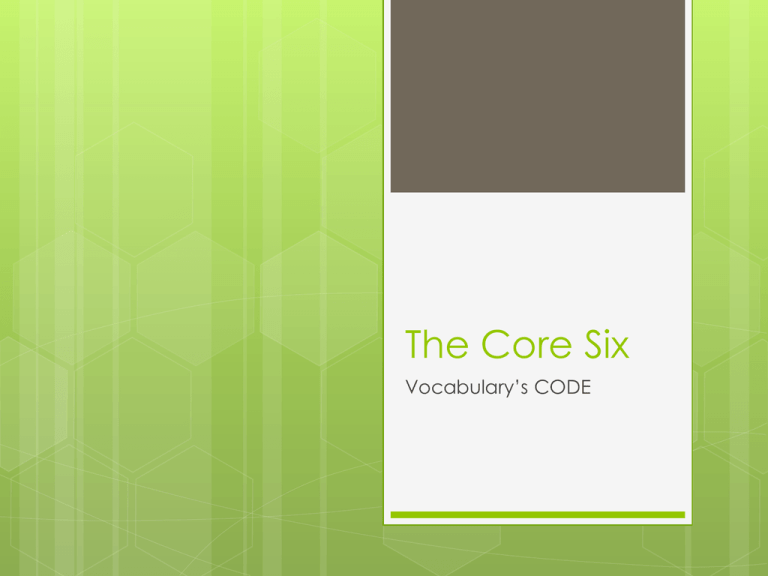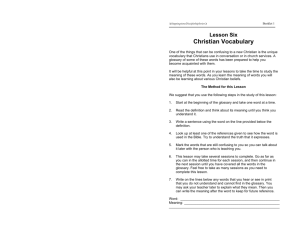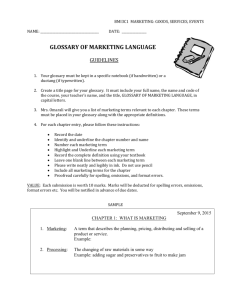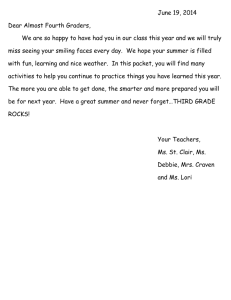Vocabulary's CODE
advertisement

The Core Six Vocabulary’s CODE In a Nutshell Vocabulary’s CODE is a strategic approach for direct vocabulary instruction that helps students master crucial concepts and retain new vocabulary terms. Students work their way from initial exposure to indepth understanding through a series of progressive, systematic learning activities, which help students “crack” Vocabulary’s CODE. Vocabulary’s CODE provides teachers with a framework and set of instructional tools to build a four-phase learning sequence which deepens students’ understanding of key words. This systematic learning includes four phases: Connecting with new words. Organizing new words into meaningful categories ensuring that students see relationships between words and how they make up a larger structure.. Deep-processing of the most important concepts and terms using thinking strategies. Exercising the mind through strategic review and practice commits new words into long-term memory. C Word Wall A collection of words is organized into categories and posted on the wall for students to use in their reading and writing. Power Decoding Students apply “attack skills” (prefixes, suffixes, roots, context clues, and substitutions) to decode new words. Associations Students generate words, pictures, feelings, physical reactions to words, about their connecting thoughts. See It, Say It, Show It, Store It Students look at the word pronounce it slowly, write it out, and record its definition in their own words. Glossary Students keep a resource glossary of new words, defining terms in their own words and can include icons or images of the terms. O D Prioritizing Vocabulary The teacher or students determine which words are essential, which are important, and which are good to know. Visualizing Vocabulary Students create images, sketches, or icons with brief explanations to demonstrate understanding of terms. Concept Maps Students create visual representations of hierarchical relationships among a central concept, supporting ideas, and important details. Fist Lists and Word Spiders The teacher provides a category in the “palm” of a hand organizer, and students generate five words that fit the category, one for each “finger” of the organizer. Word Spiders are similar, only with a “body” and eight “legs”. Word Banks Students examine a list of words and place them into specific categories or the slots of a visual organizer. Storytelling Students analyze a selection of stories and then use basic story elements to define important concepts. Group and Label Students examine a list of vocabulary words and place them into groups based on common characteristics. For each group, students devise a label which describes what all the grouped words have in common. Word Catcher/Collector A Diagram to Die For Students “catch/collect” a new word Students create a diagram that shows the each day and record it in their vocabulary relationship among the words on a Word journals or glossary. Wall. E Vocabulary Games Students play games like Bingo, Jeopardy, and Word Baseball to review vocabulary in a competitive and fun manner. Use It or Lose It Students use a specified number of new words in their writing assignments. Metaphors and Similes Students use words deeply by exploring their relationships to other words and concepts. (e.g., How is democracy like baseball?) Vocabulary Carousel The teacher sets up five or six stations that include a variety of vocabulary activities. Students rotate through all the stations, working in small groups. Defining Characteristics Students build multilayered definitions by focusing on essential characteristics: What is it? What is it used for? Why is it valued? Where does it come from? Practice Makes Perfect The teacher instructs students in the principles of effective practice, including how to mass and distribute review sessions, use words often, and make stronger connections. Three’s a Crowd Students decide which word from a group of three doesn’t belong and explain why. Etymologies Students investigate word histories, analyzing how a word’s original meaning is intact and how it has changed. Three-Way Tie Students select three words from a unit’s vocabulary and arrange them on a triangle. They connect the words with lines and explain the relationship between each pair of words by writing along the connecting lines. They may also summarize these relationships in the middle of the triangle. Peer Practice Students work as peer partners. One student serves as a coach, the other as a player. While the player works to define key terms from the unit, the coach provides assistance, feedback, and praise. Students then reverse roles.





